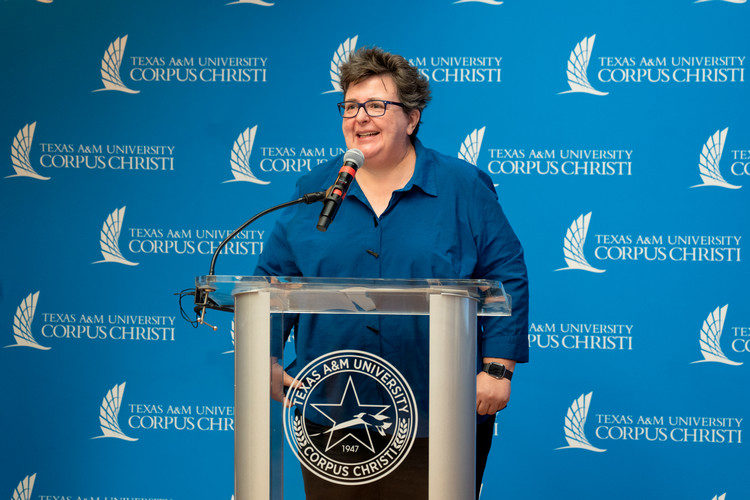The Big Blue Sea: Exploring New Depths in Marine Biology at TAMU-CC
CORPUS CHRISTI, Texas — Beneath the surface of the sparkling Gulf of Mexico lies a world teeming with life and mysteries, one that beckons to be explored and understood. For curious and brave students eager to plunge below these depths, Texas A&M-Corpus Christi offers cutting-edge research facilities, unparalleled opportunities for hands-on experience just steps from campus, and the ability to work with preeminent faculty experts both onshore and offshore.
Here on the Island, the next generation of marine scientists and conservationists are poised at the very gateway to the blue frontier. From the unseen complexity of a tiny fish to the secrets surrounding the health of bottlenose dolphins and the genetic puzzles to be solved in oyster conservation, the marine-focused programs at the Island University span an extensive breadth of the animals, plant life, and ecosystems under the sea.
Makayla Guinn ’23, ’28
As you look out over Corpus Christi Bay, you might catch a glimpse of a small research boat heading toward the horizon in pursuit of a pod of common bottlenose dolphins. This is where you’ll find Makayla Guinn, whatever the weather, taking photographs and collecting small tissue and water samples to analyze the health of the local dolphin population.
“Dolphins are apex predators and are considered bioindicator species, meaning that the health of a dolphin can reflect the overall health of a marine ecosystem,” Guinn explained. “Moreover, dolphin blubber acts as a storage site for toxic chemicals and pollutants, making the quantification of pharmaceuticals and other compounds in the tissue very important to our understanding of how land and sea are connected.”
Under the expert supervision of Dr. Dara Orbach, Assistant Professor of Marine Biology, Guinn, an Austin native and first-generation college student, undertook a marine biology master’s degree at TAMU-CC, where she studied the prevalence of skin lesions on dolphins in high-saline environments. Her work reveals that, despite high salinity environments being renowned for their healing benefits, the local dolphin population often shows the same amount of skin lesions as those in low-salinity systems, indicating that exposure to other stressors could be contributing to this phenomenon.
Guinn, now a doctoral student, said the Island University is an ideal location for her studies.
“There’s an ocean of opportunity right in our backyard,” Guinn said. “The marine biology programs at the Island University are highly multidisciplinary, have faculty with diverse areas of expertise, and house state-of-the-art instrumentation to perform groundbreaking research in every niche of marine biology.”
Alexis Trujillo ’22, ’24
Alexis Trujillo, a student of Dr. Frauke Seemann, Assistant Professor of Marine Biomedical Sciences, has embarked on a crucial investigation into the impacts of polycyclic aromatic hydrocarbon toxicity. Using fish models, he aims to untangle the complex interactions between bone development, genes, and changing environments.
Trujillo’s work in the university’s Environmental Toxicology Lab in Tidal Hall not only showcases the pioneering approaches TAMU-CC students are taking to confront pressing health issues, but also highlights the program’s deep commitment to nurturing the environmental advocates of tomorrow.
“Using Japanese Medaka fish as our models, we can shed light on the possible effects of pollutants on other animals, including humans,” he explained. “For example, assessing how a particular chemical or metal affects critical development stages in the aquatic animal model can help us better understand the underlying mechanisms in developmental biology.”
Trujillo, who graduated from Ingleside High School, earned a Bachelor of Science in Biomedical Science from TAMU-CC and is now a graduate student. Currently in the experimentation phase of his thesis work, Trujillo’s days are filled with lab work, fish husbandry, and immunofluorescence and immunohistochemistry experiments.
“The location of our university plays a tremendous role in our research capabilities,” Trujillo said. “What’s more, the life science faculty are some of the most interesting, wise, passionate, and ambitious people I’ve ever had the privilege of meeting, and it is an honor to work alongside them.”
Allison Weber ‘28
For Island University doctoral student Allison Weber, whose childhood surrounded by Missouri rivers and lakes cultivated a deep love of aquatic systems, the marine biology doctoral program at TAMU-CC was an easy choice.
“A standout feature of graduate studies on the Island has been the sense of camaraderie between students and faculty,” she said. “The practical experience I am gaining here is incomparable, as well as the networking opportunities.”
Weber said she has also greatly benefited from the supervision of Dr. Chris Hollenbeck, Assistant Professor of Fisheries and Mariculture, whose knowledge of genetics and the Texas oyster aquaculture industry has been pivotal to her work concerning the genetic composition of eastern oysters. Her research involves developing a genetic test to assess the population and lineage of Coastal Bend oysters; she is also investigating the genetic and reproductive mechanisms of eastern oyster hybrids, which are a key element to the future of oyster fisheries and aquaculture industry in Texas.
“The impact of my work will fill critical gaps in our understanding of oyster population genetics, which is crucial to developing informed conservation and resource management strategies,” Weber explained. “By providing these insights to inform aquaculture practices, my research both aids restoration and supports sustainable fisheries and economic growth.”
As the journeys of these three marine biology students unfold, their work not only promises to advance our comprehension of the marine world but also inspires a new wave of Islanders who stand to become the educators and stewards of our oceans for years to come.













